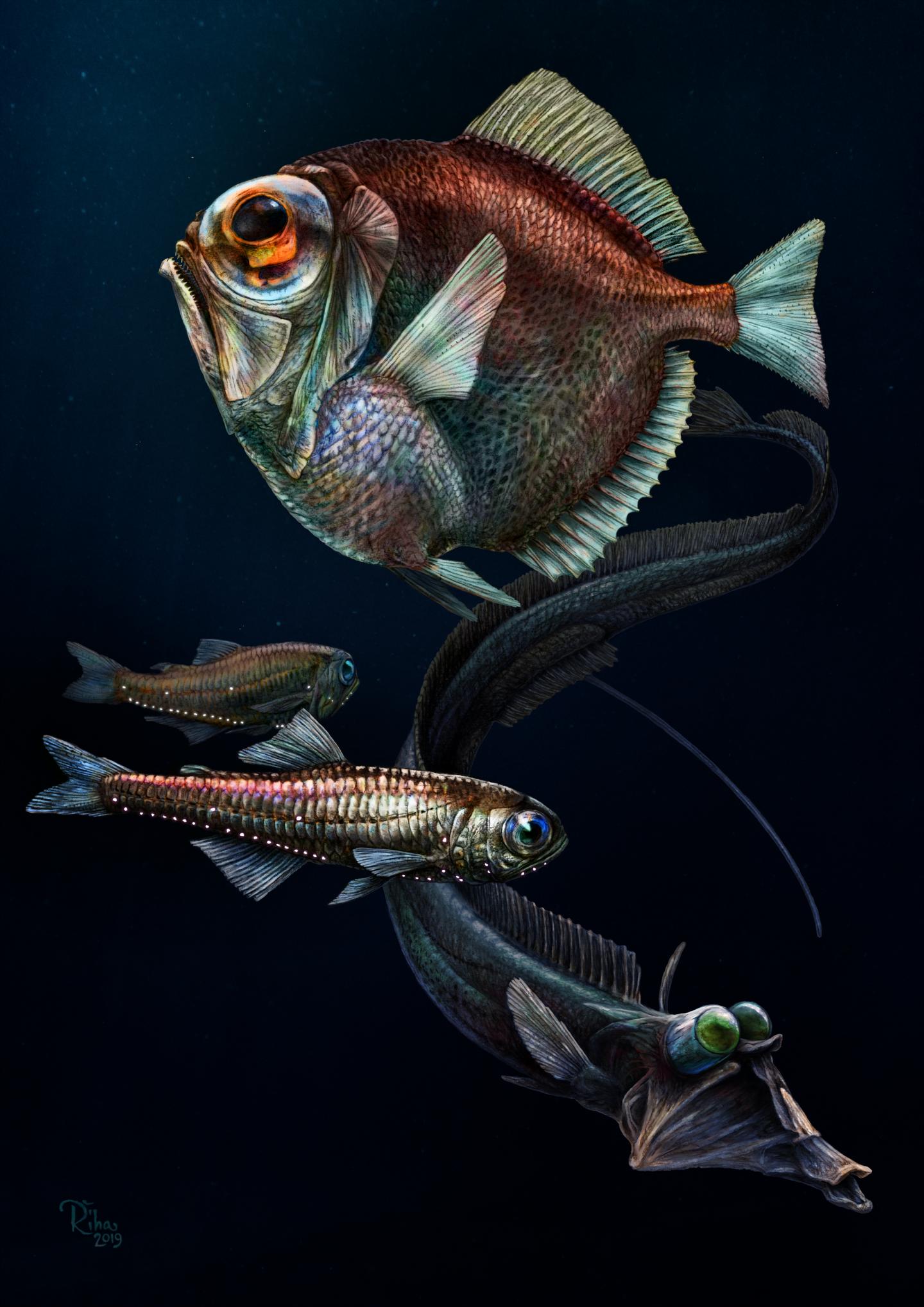New research reveals signs of highly sensitive color vision in fish that live in the abyss beyond sunlight’s reach

Credit: Pavel Riha, University of South Bohemia, Ceske Budejovice, Czech Republic
An international team of researchers discovered a previously unknown visual system that may allow color vision in deep, dark waters where animals were presumed to be colorblind. The research appears on the cover of the May 10, 2019, issue of the journal Science.
“This is the first paper that examines a diverse set of fishes and finds how versatile and variable their visual systems can be,” said Karen Carleton, a biology professor at the University of Maryland and co-author of the paper. “The genes that determine the spectrum of light our eyes are sensitive to turn out to be a much more variable set of genes, causing greater visual system evolution much more quickly than we anticipated.”
Vertebrate eyes use two types of photoreceptor cells to see–rods and cones. Both rods and cones contain light-sensitive pigments called opsins, which absorb specific wavelengths of light and convert them into electrochemical signals that the brain interprets as color. The number and type of opsins expressed in a photoreceptor cell determine the colors an animal perceives.
Before this new study, it was accepted that cones are responsible for color vision, and rods are responsible for detecting brightness in dim conditions. This new work indicates that is not strictly the case. By analyzing the genomes of 101 fish, the researchers discovered that some fish contained multiple rod opsins raising the possibility they have rod-based color vision.
Cones typically contain genes for expressing multiple opsins, which is why they are used for color vision. But they are not as sensitive as rods, which can detect a single photon and are used for low-light vision. In 99% of all vertebrates, rods express just one type of light-sensitive opsin, which means the vast majority of vertebrates are colorblind in low-light conditions.
Vision in most deep-sea fish follows this same pattern, but the new research revealed some remarkable exceptions. By analyzing the genes for expressing opsins in rods and cones of fish living from the shallow surface waters down to 6,500 feet of depth, the researchers found 13 fish with rods that contained more than one opsin gene. Four of those, all deep-sea fish, contained more than three rod opsin genes.
Most remarkable was the silver spinyfin fish, which had a surprising 38 rod opsin genes. That is more opsins than the researchers found in the cones of any other fish and the highest number of opsins found in any known vertebrate. (Human vision by comparison uses four opsins). In addition, the rod opsins found in silver spinyfin fish are sensitive to different wavelengths.
“This was very surprising,” Carleton said. “It means the silver spinyfin fish have very different visual capabilities than we thought. So, the question then is, what good is that? What could these fish use these spectrally different opsins for?”
Carleton believes the answer may have to do with detecting the right prey. It has long been presumed that animals living in very deep water have no need for color vision, because only blue light penetrates deeper than 600 feet. But despite the lack of sunlight, the deep sea is not devoid of color. Many animals that live in darkness generate their own light through bioluminescence.
The new study found that in fish with multiple rod opsins, the specific wavelength of light their opsins are tuned to overlap with the spectrum of light emitted by the bioluminescent creatures that share their habitat.
“It may be that their vision is highly tuned to the different colors of light emitted from the different species they prey on,” Carleton said.
It’s important to note that the four species of fish found to have more than three rod opsins are unrelated species. This suggests that rod-based color vision, which can be thought of as deep-water color vision, evolved independently multiple times and must confer some benefit to survival.
The researchers say their next steps are to broaden the study to other deep-sea fish and to look for shallow-water relatives of silver spinyfin fish that may have evolved a large number of rod opsins.
###
This research was conducted in collaboration with researchers from the University of Queensland in Australia, Charles University in the Czech Republic and the University of Basel in Switzerland.
The research paper “Vision using multiple distinct rod opsins in deep-sea fishes,” Zuzana Musilova, Fabio Cortesi, Michael Matschiner, Wayne I. L. Davies, Jagdish Suresh Patel, Sara M. Stieb, Fanny de Busserolles, Martin Malmstrøm, Ole K. Tørresen, Celeste J. Brown11, Jessica K. Mountford, Reinhold Hanel, Deborah L. Stenkamp, Kjetill S. Jakobsen, Karen L. Carleton, Sissel Jentoft, Justin Marshall, Walter Salzburger, was published in the journal Science on May 10, 2019.
Media Contact
Kimbra Cutlip
[email protected]
Original Source
https:/
Related Journal Article
http://dx.




